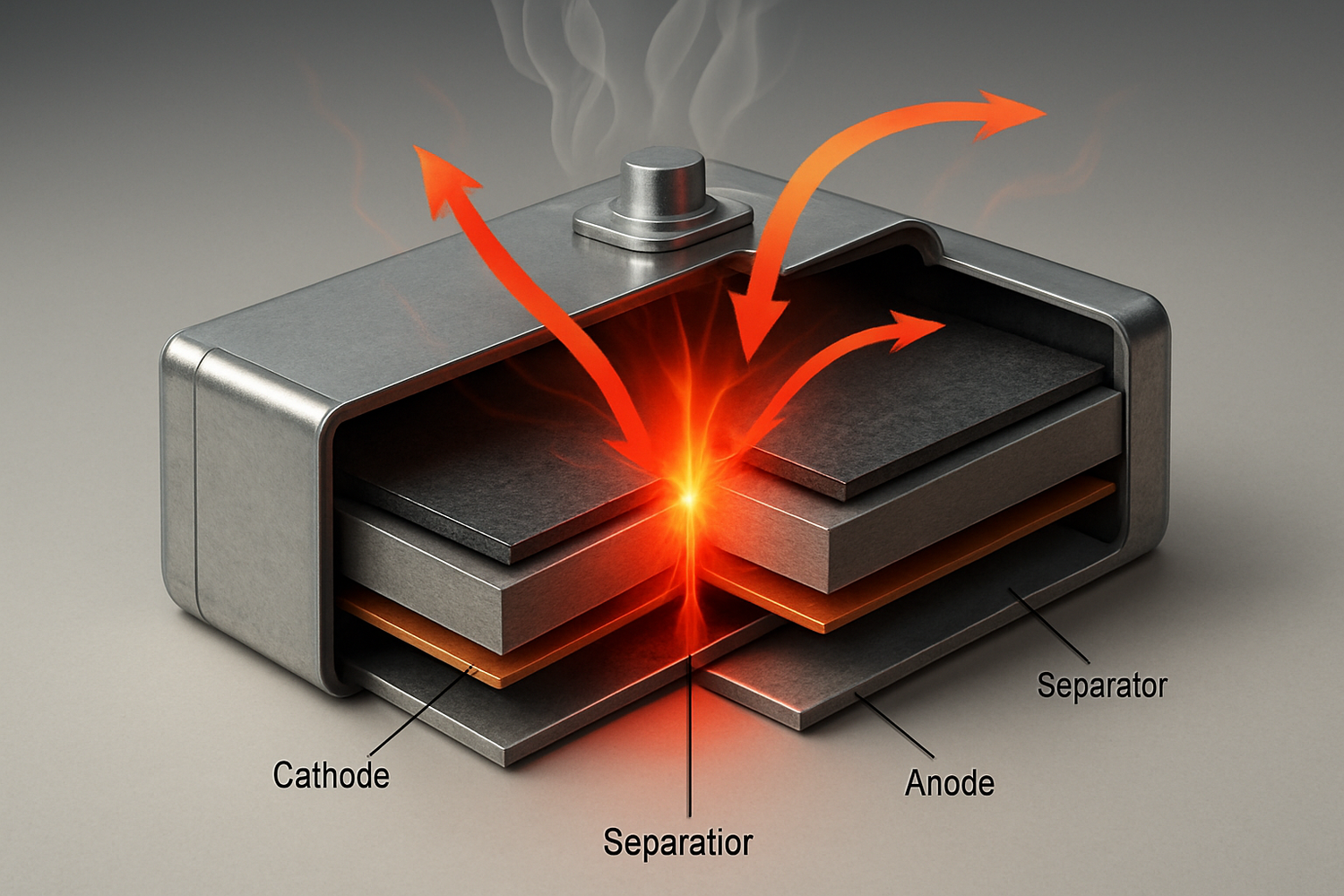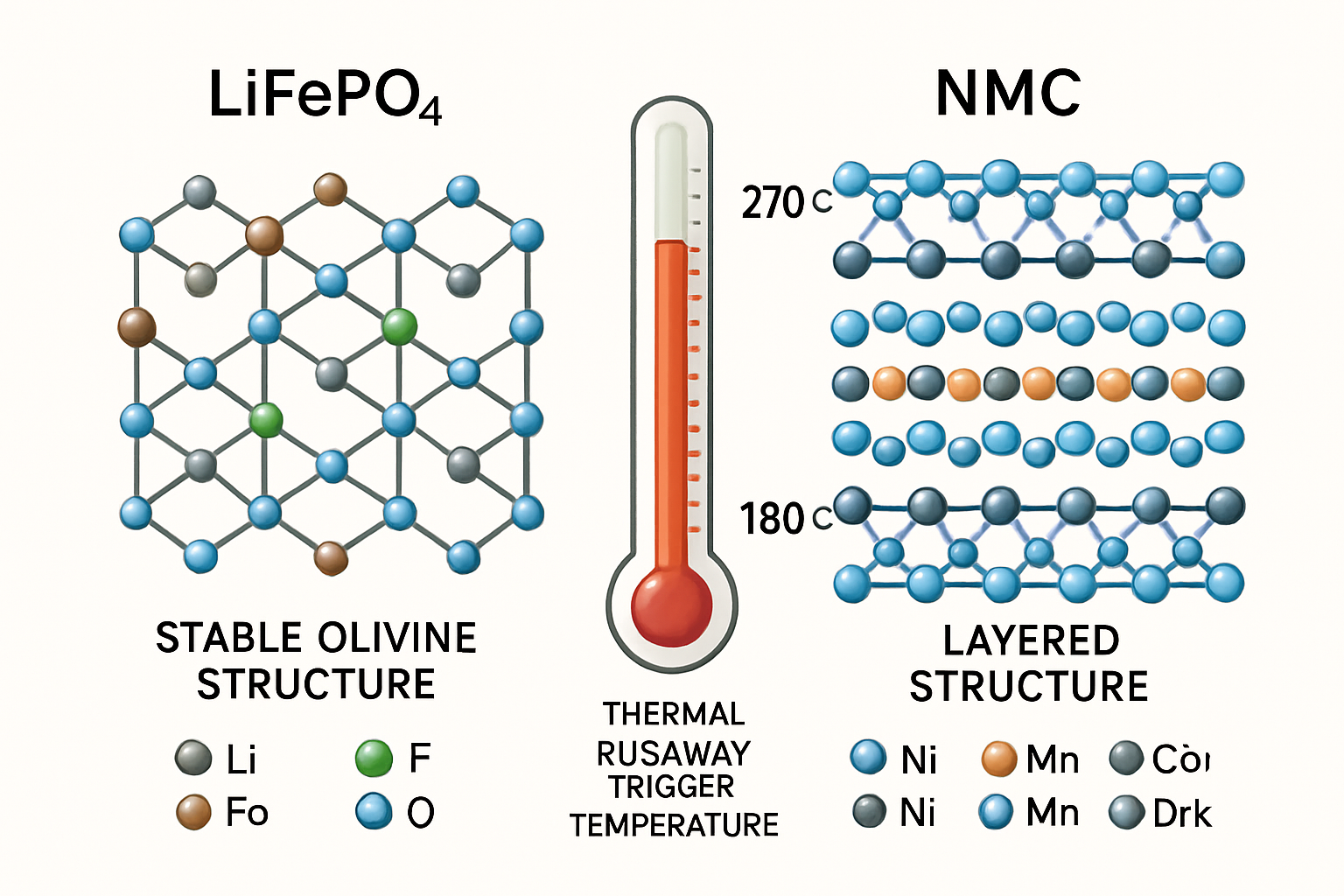Lithium-ion batteries are the cornerstone of modern energy storage, powering everything from electric vehicles to home battery systems. Their ability to store significant energy in a compact space is unmatched. However, with this power comes the responsibility of understanding their operational limits and failure modes. The most critical of these is thermal runaway, a term that describes an unstoppable, self-heating chain reaction. This guide explains the science behind thermal runaway, its primary causes, and the most effective strategies for prevention and mitigation, ensuring your energy storage system operates safely and reliably.
What is Thermal Runaway in Lithium-Ion Batteries?
At its core, thermal runaway is a rapid, uncontrolled release of stored energy. It's a feedback loop where increasing temperature causes a chemical reaction that generates even more heat. Understanding this process is the first step toward preventing it.
The Chemical Chain Reaction Explained
A lithium-ion battery cell contains a positive electrode (cathode), a negative electrode (anode), a separator, and a liquid electrolyte. The separator is a micro-perforated membrane that keeps the electrodes from touching while allowing ions to pass through. The process of thermal runaway typically unfolds in stages:
- Initial Failure: An event, such as an internal short circuit, causes a localized spot in the cell to heat up.
- Separator Breakdown: As the temperature rises, the plastic separator melts. This allows the cathode and anode to come into direct contact, creating more short circuits and generating significantly more heat.
- Electrolyte Decomposition: The intense heat causes the liquid electrolyte to break down, releasing flammable and toxic gases. This process, known as 'off-gassing', rapidly increases the pressure inside the cell.
- Cell Rupture: The pressure becomes too great for the cell's casing to contain, leading to a rupture. The flammable gases can ignite upon contact with air, resulting in fire or, in some cases, an explosion. This reaction can then spread to adjacent cells.
Key Triggers for Thermal Runaway
Several conditions, often referred to as 'abuse factors', can initiate thermal runaway. These fall into four main categories:
- Mechanical Abuse: Physical damage such as being punctured, crushed, or subjected to severe vibration can cause internal short circuits.
- Electrical Abuse: Overcharging a battery beyond its maximum voltage, over-discharging it below its minimum voltage, or drawing current too quickly can lead to excessive heat and chemical instability.
- Thermal Abuse: Exposing the battery to high external temperatures, such as from a nearby fire or direct sunlight in a poorly ventilated area, can raise the internal cell temperature to a critical point.
- Internal Defects: Microscopic manufacturing flaws, though rare in high-quality cells, can create pathways for an internal short circuit to develop over time.
The Role of Battery Chemistry in Fire Safety
Not all lithium-ion batteries are created equal. The specific materials used in the cathode have a profound impact on the battery's safety profile, particularly its resistance to thermal runaway.
Comparing LiFePO4 and NMC Batteries
The two most common chemistries in energy storage are Lithium Iron Phosphate (LiFePO4) and Nickel Manganese Cobalt (NMC). LiFePO4 chemistry is widely recognized for its superior safety. Its olivine crystal structure is exceptionally stable and less likely to release oxygen during a high-heat event. Since oxygen is a key ingredient for fire, this chemical stability dramatically reduces the risk of combustion. NMC batteries, while offering higher energy density, have a less stable chemical structure that can release oxygen when overheated, potentially fueling a fire.
| Feature | LiFePO4 (Lithium Iron Phosphate) | NMC (Nickel Manganese Cobalt) |
|---|---|---|
| Thermal Runaway Threshold | ~270°C / 518°F | ~210°C / 410°F |
| Chemical Stability | Very High (stable olivine structure) | Moderate |
| Oxygen Release at High Temp | Minimal | Significant |
| Safety Profile | Excellent | Good (requires more complex safety systems) |
Thermal Runaway Thresholds: A Data-Driven Look
The temperature at which thermal runaway begins is a critical safety metric. LiFePO4 batteries have a significantly higher thermal runaway threshold, starting at approximately 270°C (518°F). In contrast, NMC batteries can enter thermal runaway at a lower temperature of around 210°C (410°F). This wider safety margin means that a LiFePO4 battery can withstand more extreme conditions before becoming unstable, making it an inherently safer choice for a home energy storage system.
Proactive Prevention and Mitigation Strategies
Preventing thermal runaway involves a multi-layered approach that combines intelligent system design, professional installation, and adherence to certified safety standards.
The Critical Function of a Battery Management System (BMS)
The Battery Management System (BMS) is the electronic brain of a battery pack. Its primary job is to ensure the battery operates within its safe limits. A sophisticated BMS continuously monitors cell voltage, temperature, and current. It will automatically disconnect the battery to prevent dangerous conditions like overcharging, over-discharging, and overheating, providing the first and most critical line of defense against electrical abuse.
Proper Installation and Environmental Control
Even the best battery can be compromised by poor installation. A professional installation ensures that all electrical connections are secure, the system is protected from physical damage, and it has adequate ventilation. Maintaining a stable operating environment is also crucial. Batteries should be installed in a location that avoids extreme temperatures and direct sunlight. Understanding key performance metrics is also vital for maintaining system health. As detailed in the ultimate reference on solar storage performance, monitoring efficiency and depth of discharge can help identify operational issues before they lead to unsafe conditions.
The Significance of Safety Certifications
Third-party safety certifications provide assurance that an energy storage system has undergone rigorous testing. The most important standard is UL 9540, which covers the entire energy storage system, including the batteries, inverter, and control systems. This system-level certification ensures all components work together safely. The batteries themselves are often tested to UL 1973, while UL 9540A is a specific test method used to evaluate how a system behaves during a thermal runaway event, assessing its ability to prevent fire from spreading between cells.
Emergency Response Protocol for Thermal Runaway Events
Disclaimer: This information is for educational purposes and is not a substitute for professional emergency response training. Always prioritize personal safety and follow the guidance of local emergency services.
Immediate Actions to Take
In the unlikely event of a battery fire, your response should be focused on safety.
- Evacuate: Immediately leave the area. Do not attempt to retrieve personal belongings.
- Alert Others: Make sure everyone else in the building is aware of the situation and evacuating.
- Contact Emergency Services: Call your local emergency number (e.g., 911) and explicitly state that it is a lithium-ion battery fire. This information is vital for first responders, as these fires require a specific approach.
What First Responders Do
Fighting a lithium-ion battery fire is different from a conventional fire. Because the cells can generate their own oxygen, simply smothering the fire is often ineffective. The primary strategy used by firefighters is to apply large quantities of water for cooling. The goal is less about extinguishing the flames and more about lowering the temperature of the burning and adjacent cells to stop the propagation of the thermal runaway chain reaction. They are trained to manage the risks of toxic fumes and potential re-ignition due to 'stranded energy' remaining in the battery pack.
A Safer Energy Future
Thermal runaway is a serious event, but it is also a manageable risk. Through a combination of safer battery chemistries like LiFePO4, advanced Battery Management Systems, professional installation, and adherence to stringent safety standards like UL 9540, the risk of fire in modern home energy storage systems is exceptionally low. As organizations like the International Renewable Energy Agency (IRENA) note, continued innovation and harmonized operational standards are key to the expanding role of energy storage in our global energy transition. By understanding the science and prioritizing safety, you can confidently embrace the benefits of energy independence.
Frequently Asked Questions
Can a LiFePO4 battery experience thermal runaway?
Yes, under extreme abuse conditions, any battery can fail. However, it is far less likely in a LiFePO4 battery compared to other lithium-ion chemistries. LiFePO4 batteries have a much higher thermal runaway threshold and a more stable chemical structure that does not release oxygen, making them inherently safer for applications like home energy storage.
What does thermal runaway smell like?
Before a fire, failing lithium-ion cells can vent electrolyte gases. These gases may have a distinct sweet, metallic, or acrid chemical odor. If you notice any unusual smells coming from your battery system, treat it as a critical warning sign. You should power down the system if possible and contact your installer for an immediate inspection.
Is it safe to have a lithium-ion battery storage system in my home?
Yes, a professionally installed home energy storage system that uses a stable chemistry like LiFePO4 and is certified to safety standards like UL 9540 is considered very safe. These systems are engineered with multiple layers of protection, from the cell chemistry to the BMS and thermal management, to ensure reliable and secure operation.





Leave a comment
All comments are moderated before being published.
This site is protected by hCaptcha and the hCaptcha Privacy Policy and Terms of Service apply.